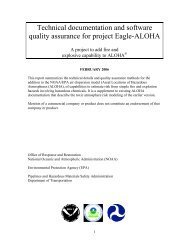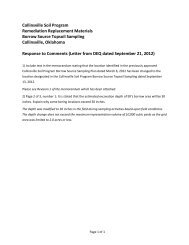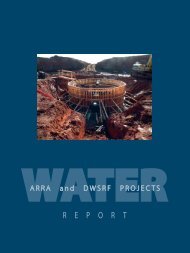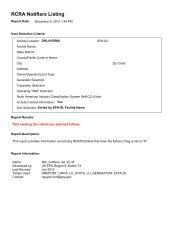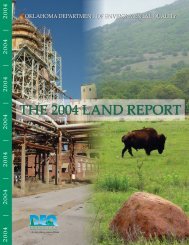Oklahoma Gas & Electric Muskogee Generating Station Best ...
Oklahoma Gas & Electric Muskogee Generating Station Best ...
Oklahoma Gas & Electric Muskogee Generating Station Best ...
You also want an ePaper? Increase the reach of your titles
YUMPU automatically turns print PDFs into web optimized ePapers that Google loves.
<strong>Oklahoma</strong> <strong>Gas</strong> & <strong>Electric</strong><br />
<strong>Muskogee</strong> <strong>Generating</strong> <strong>Station</strong> – BART Determination<br />
May 28, 2008<br />
Table 4-3 continued:<br />
Control<br />
Technology<br />
Wet FGD with<br />
WESP<br />
Dry FGD – Spray<br />
Dryer Absorber<br />
Dry Sorbent<br />
Injection<br />
Circulating Dry<br />
Scrubber<br />
SO2 Emission Rate<br />
In Service on<br />
Existing PC<br />
Boilers?<br />
(lb/mmBtu) Yes No<br />
NA X<br />
0.10 lb/mmBtu<br />
(approx. 50 ppmvd @<br />
3% O2)<br />
0.4 lb/mmBtu<br />
(approx. 200 ppmvd<br />
@ 3% O2)<br />
X<br />
X<br />
NA X<br />
49<br />
In Service on<br />
Other<br />
Combustion<br />
Sources?<br />
The WESP control<br />
system is in use at<br />
a limited number of<br />
high-sulfur coal-<br />
fired units.<br />
In use on sub-<br />
bituminous coal-<br />
fired boilers.<br />
Dry sorbent<br />
injection has been<br />
used on a limited<br />
number of coalfired<br />
units.<br />
CDS is in use at a<br />
limited number of<br />
coal-fired boilers.<br />
Step 3: Rank the Technically Feasible SO2 Control Options by Effectiveness<br />
Technically Feasible Retrofit<br />
Technology for <strong>Muskogee</strong> Units<br />
4 & 5?<br />
Not technically feasible nor<br />
commercially available for units<br />
firing a low-sulfur subbituminous<br />
coal.<br />
Technically feasible.<br />
Technically feasible, but not as<br />
effective as other SO2 control<br />
options therefore excluded as<br />
BART.<br />
CDS Dry FGD was determined<br />
not to be commercially available<br />
for <strong>Muskogee</strong> Units 4 & 5 (large<br />
sub- bituminous fired units). In<br />
addition, there is no commercial<br />
experience with units similar to<br />
<strong>Muskogee</strong> Units 4 & 5, so CDS-<br />
DFGD was excluded as BART.<br />
Both technically feasible SO2 retrofit technologies (i.e., Wet- and Dry-FGD) are capable of meeting<br />
the BART presumptive level of 0.15 lb/mmBtu. However, in order to evaluate the cost<br />
effectiveness of each control technology, annual emissions and costs were estimated at the design<br />
emission limits of 0.08 lb/mmBtu for WFGD and 0.10 lb/mmBtu for DFGD. This approach was<br />
taken in order to determine whether either control technology was cost effective at the anticipated<br />
design emission rate. The technically feasible SO2 control technologies are listed in Table 4-4 in<br />
descending order of control efficiency based on anticipated design emission rates.



